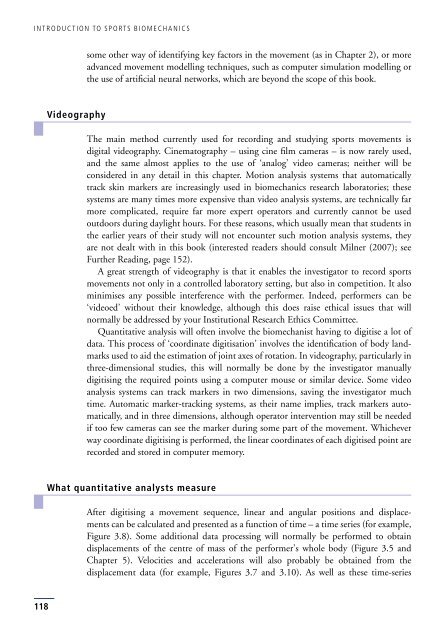Introduction to Sports Biomechanics: Analysing Human Movement ...
Introduction to Sports Biomechanics: Analysing Human Movement ...
Introduction to Sports Biomechanics: Analysing Human Movement ...
Create successful ePaper yourself
Turn your PDF publications into a flip-book with our unique Google optimized e-Paper software.
INTRODUCTION TO SPORTS BIOMECHANICS<br />
118<br />
Videography<br />
some other way of identifying key fac<strong>to</strong>rs in the movement (as in Chapter 2), or more<br />
advanced movement modelling techniques, such as computer simulation modelling or<br />
the use of artificial neural networks, which are beyond the scope of this book.<br />
The main method currently used for recording and studying sports movements is<br />
digital videography. Cinema<strong>to</strong>graphy – using cine film cameras – is now rarely used,<br />
and the same almost applies <strong>to</strong> the use of ‘analog’ video cameras; neither will be<br />
considered in any detail in this chapter. Motion analysis systems that au<strong>to</strong>matically<br />
track skin markers are increasingly used in biomechanics research labora<strong>to</strong>ries; these<br />
systems are many times more expensive than video analysis systems, are technically far<br />
more complicated, require far more expert opera<strong>to</strong>rs and currently cannot be used<br />
outdoors during daylight hours. For these reasons, which usually mean that students in<br />
the earlier years of their study will not encounter such motion analysis systems, they<br />
are not dealt with in this book (interested readers should consult Milner (2007); see<br />
Further Reading, page 152).<br />
A great strength of videography is that it enables the investiga<strong>to</strong>r <strong>to</strong> record sports<br />
movements not only in a controlled labora<strong>to</strong>ry setting, but also in competition. It also<br />
minimises any possible interference with the performer. Indeed, performers can be<br />
‘videoed’ without their knowledge, although this does raise ethical issues that will<br />
normally be addressed by your Institutional Research Ethics Committee.<br />
Quantitative analysis will often involve the biomechanist having <strong>to</strong> digitise a lot of<br />
data. This process of ‘coordinate digitisation’ involves the identification of body landmarks<br />
used <strong>to</strong> aid the estimation of joint axes of rotation. In videography, particularly in<br />
three-dimensional studies, this will normally be done by the investiga<strong>to</strong>r manually<br />
digitising the required points using a computer mouse or similar device. Some video<br />
analysis systems can track markers in two dimensions, saving the investiga<strong>to</strong>r much<br />
time. Au<strong>to</strong>matic marker-tracking systems, as their name implies, track markers au<strong>to</strong>matically,<br />
and in three dimensions, although opera<strong>to</strong>r intervention may still be needed<br />
if <strong>to</strong>o few cameras can see the marker during some part of the movement. Whichever<br />
way coordinate digitising is performed, the linear coordinates of each digitised point are<br />
recorded and s<strong>to</strong>red in computer memory.<br />
What quantitative analysts measure<br />
After digitising a movement sequence, linear and angular positions and displacements<br />
can be calculated and presented as a function of time – a time series (for example,<br />
Figure 3.8). Some additional data processing will normally be performed <strong>to</strong> obtain<br />
displacements of the centre of mass of the performer’s whole body (Figure 3.5 and<br />
Chapter 5). Velocities and accelerations will also probably be obtained from the<br />
displacement data (for example, Figures 3.7 and 3.10). As well as these time-series






